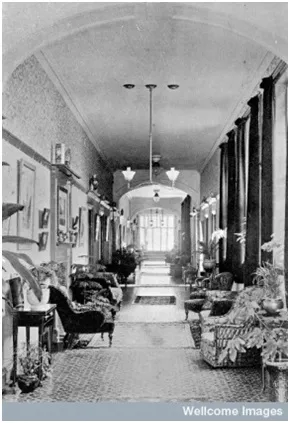The York Retreat
Claire Sewell
 The Retreat near York (1813) The Retreat near York (1813) |
 |
| The Fourth Gallery of The Retreat, York (1887) |
“Thee has had many wonderful children of thy brain dear William, but this one is surely to be an idiot” (Esther Tuke, c.1796).
Despite Esther’s reservations, her husband, Quaker tea merchant William Tuke (1732-1822) founded the Retreat, a private asylum in York, in 1796. The asylum was set up in response to an unexplained death in 1791, of a Quaker woman in the York Asylum. Established for Quaker patients, the Retreat was intentionally small in size, initially taking in around thirty patients. With one staff member to every ten patients, the Retreat came to typify the ‘moral management’ approach, with community and humanity replacing restraint and medication. Yet rather than using manacles to physically retrain patients, the Retreat utilised what historian Roy Porter has described as ‘the therapeutic power of fear’. As William’s grandson, Samuel Tuke (1784-1857), explained in 1813:
The principle of fear, which is rarely decreased by insanity, is considered as of great importance in the management of the patients. But it is not allowed to be excited, beyond the degree which naturally arises from the necessary regulations of the family. Neither chains nor corporal punishments are tolerated, on any pretext in this establishment. The patients, therefore, cannot be threatened with these severities; yet, in all houses established for the reception of the insane, the general comfort of the patients ought to be considered; and those who are violent, require to be separated from the more tranquil, and to be prevented, by some means, from offensive conduct, towards their fellow-sufferers. (Samuel Tuke, Description of the Retreat, an Institution near York, for Insane Persons (York: W. Alexander, 1813), p.141.)
The Retreat emphasised domesticity in terms of its general atmosphere, architecture and its attitude to patient care; patients were treated as the children of a family headed by the asylum’s superintendent. In a supportive atmosphere, akin to that of a normal Quaker family, it was thought that patients would be able to learn, in the words of Samuel Tuke, to ‘restrain themselves’. As such, the Retreat aimed to return patients to a normal social life, by means of exercise, good diet and relaxation. Patients were even invited to have tea with the superintendent and his family. Built on a hill to maximise the circulation of fresh air and surrounded by lovely gardens, the Retreat was designed without a high perimeter wall and without bars on the window, thus giving the impression that no barriers separated patients from the outside world. However, the wall was replaced by a deep pit and the bars by reinforced windows.
In the nineteenth century the number of asylums increased rapidly after new legislation was passed in 1845 making it compulsory for counties to open public asylums catering mainly for pauper patients. The design of these new institutions was based on the model of the Retreat, and focused on what sociologist Andrew Scull has described as 'a curative environment for the mad'. Designed with cure in mind, these new asylums were intended to be manageable in size and have a domestic architectural style. However, in reality these large public asylums bore little relation to the Retreat, not least because of a sharp rise in the number of admissions which led to a rapid expansion of the institutions. The domestic environment and favourable ratios between staff and patients was soon lost. However, the Retreat was not an isolated example of moral management. Thomas Bakewell's Spring Vale private asylum, which opened in Staffordshire in 1808, operated according to the philosophy, 'treat them as rational beings, and they will become rational; treat them as lunatics and they will remain as such'. Yet even so, as historian Leonard Smith has pointed out, both Spring Vale and the Retreat did, on occasion, utilise mechanical restraints. Despite the problems inherent with converting the approach of moral management to larger institutions, the image of the Retreat remained durable as a new model and philosophy. Indeed, the new therapeutic communities that emerged during the twentieth century, including R.D. Laing's work at the Philadelphia Association, continued to allude to the pioneering work of the Tuke family.
Further Reading:
• Allan Ingram (ed.), Patterns of Madness in the Eighteenth Century: A Reader (Liverpool: Liverpool University Press, 1998).
• Roy Porter, Mind-Forg’d Manacles: A History of Madness in England from the Restoration to the Regency (London: Athlone, 1987; Penguin edn, 1990).
• Andrew Scull, The Most Solitary of All Afflictions: Madness and Society in Britain, 1700-1900 (London: Yale University Press, 1993).
• Leonard Smith, '“To Cure those Afflicted with the Disease of Insanity”: Thomas Bakewell and Spring Vale Asylum', History of Psychiatry, 4 (1993), pp.107-127.
